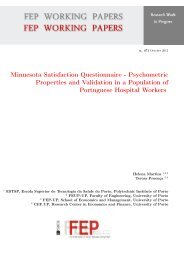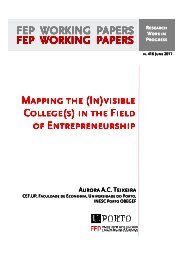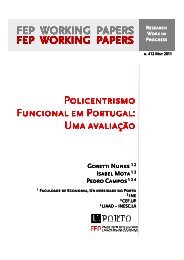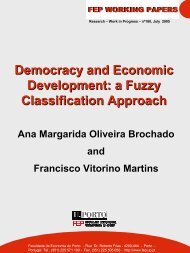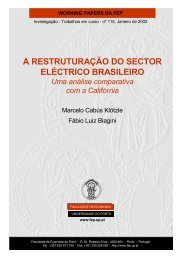FEP - Working Papers - Universidade do Porto
FEP - Working Papers - Universidade do Porto
FEP - Working Papers - Universidade do Porto
Create successful ePaper yourself
Turn your PDF publications into a flip-book with our unique Google optimized e-Paper software.
is better to construct a shopping mall than to construct another department store.<br />
This result makes us wonder whether it is not better for the department store that sells<br />
the n goods to separate into a shopping mall with n single-product shops. We investigate<br />
this possibility in the next subsection.<br />
3.3 Competition between two shopping malls<br />
In the case of competition between two shopping malls (one at each extreme of the city),<br />
there are 2n independent stores that maximize their individual profits.<br />
The stores selling the same good in different locations are direct competitors. However,<br />
the demand of a store also depends on the price of the other goods sold in the mall where<br />
it is located. A store that sells good i benefits from: (i) a low price for the good j sold<br />
at the same location (since this attracts customers to its location); (ii) a high price for<br />
the good j sold at the other location (since this repels customers from the other location).<br />
This interdependence across goods occurs because when deciding where to buy each good,<br />
a costumer takes into account not only the price but also the transportation costs that she<br />
has to support.<br />
Lemma 2. When there are two shopping malls in the city, no consumer shops at both<br />
extremes of the city (in equilibrium).<br />
Proof. See Appendix.<br />
Combining Lemma 1 and Lemma 2, we conclude that no consumer finds it worthwhile<br />
to travel to both extremes of the city.<br />
Corollary 1. In equilibrium, regardless of the mode of retail, there is “one stop shopping”.<br />
Proposition 3. In the case of competition between two shopping malls:<br />
(1) The price of each good is equal to the transportation cost parameter:<br />
piL = piR = t, ∀i ∈ I.<br />
(2) Consumers make all their purchases at the closest shopping mall:<br />
15



